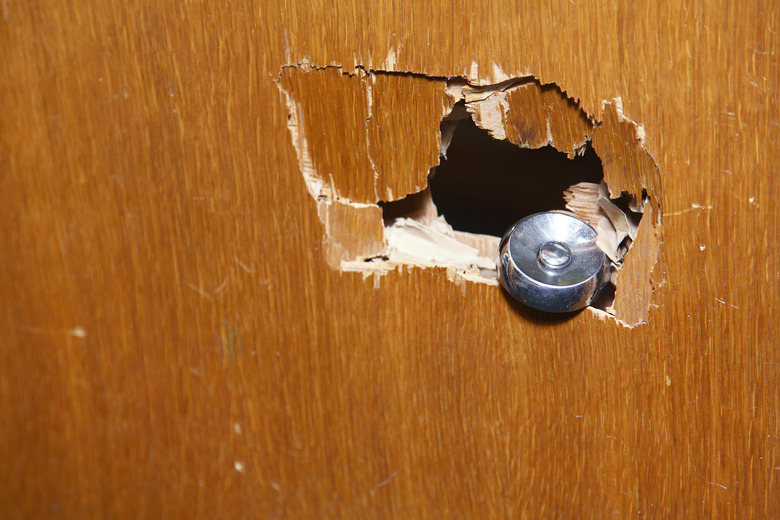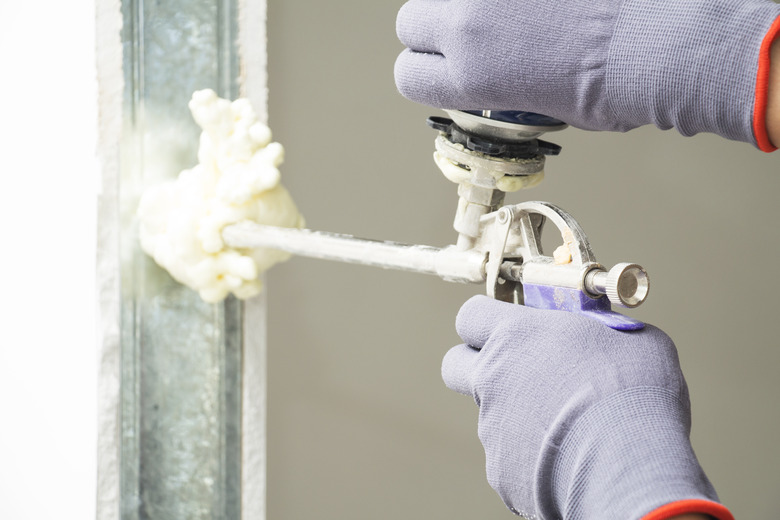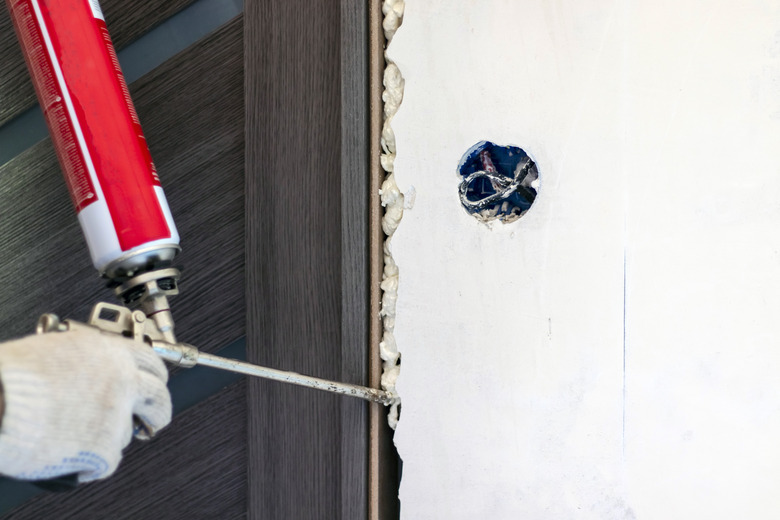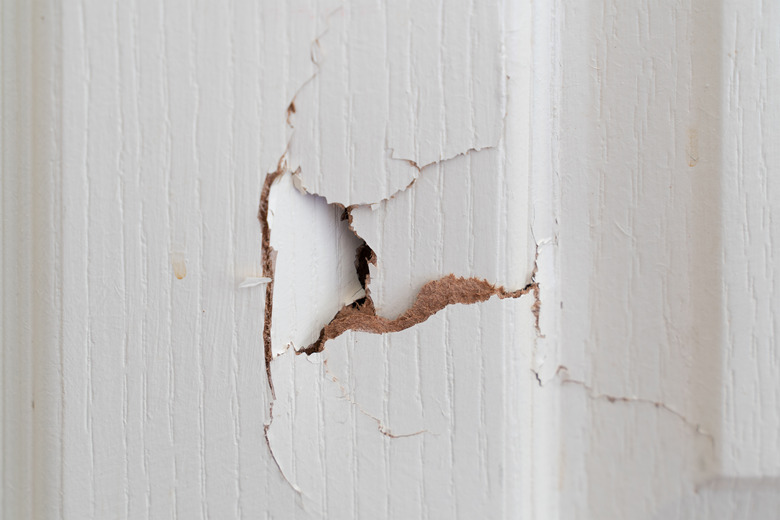How To Fix A Hole In A Door: An Easy DIY Guide
We may receive a commission on purchases made from links.
Unlike solid-core doors, the average hollow-core door is lightweight, somewhat fragile, and easy to damage, and people accidentally puncture their interior hollow-core doors all the time. They might smash one with the leg of a chair that's being moved from one room to another or slam one into a doorstop they forgot was there. Such incidents often make a hole in the door, and when that happens, the repair can't wait.
The only way to fix a hole in a door is to fill it — and it can be tricky to get the filler to stick in the hole and prevent it from cracking after it hardens. But, there is a simple DIY hack that is guaranteed to make the filler stay right where you put it without cracking. It's an easy process that even someone with limited woodworking know-how can do. You can also use this procedure to patch holes in drywall and other flimsy materials, but you'll have to resign yourself to painting the door to make the repair disappear. That's a bit of extra effort, but it's better than buying a new door.
An Overview of the Project
An Overview of the Project
The secret ingredient for repairing a hole in a hollow-core door is spray foam insulation. When you spray it into the hole, it expands to fill the void between the panels and hardens. You want low-expansion foam for this because high-expanding foam is unnecessarily messy and difficult to control, and it may make the door panels bulge. A low-expansion insulating foam designed for filling gaps around door and window frames, such as Great Stuff Window and Door Insulation, is perfect.
After you spray foam into the hole and it hardens, you simply cut it flush to the door surface and apply the filler. You can use wood filler, but you get a smoother, more crack-resistant surface by using fiberglass auto body filler, such as Bondo. You can sand this flat enough to render the repair unnoticeable under a coat of paint, but if you want to go the extra mile and make a truly seamless repair, there's an optional third step: Apply a topcoat of drywall joint compound or spackle compound, which will fill tiny imperfections in the filler and sand completely smooth.
Tips for Using Spray Foam in a Door Repair
Tips for Using Spray Foam in a Door Repair
If this is your first experience with spray foam, be warned: This stuff sticks to everything, including your clothes, your hands, and the carpet, and it's extremely difficult to remove. Nothing dissolves it, so if you get it on your clothes, you might never get it off, and if you get it on your skin, you sometimes have to wait for it to wear off naturally as your skin cells die off and regenerate.
The can comes with a removable trigger and tube, and once you attach them to the nozzle on the can, keep a rag underneath the end of the tube or wrap the rag around the tube when you aren't actually spraying. Wear rubber gloves when spraying and put on work clothes that you don't mind ruining. The job will consume a fraction of the contents of a can, so if you want to be able to use the rest of the contents at a later date for another project, do the following when you're finished with this project:
- Pull the trigger off the nozzle and separate it from the tube. Set the nozzle and can aside to let the foam inside them cure.
- Insert a length of wire into the tube that extends all the way through it and wait for the foam to cure.
- Pull the wire out of the tube after the foam has hardened. At the same time, pull the hardened foam out of the nozzle and trigger using needle-nose pliers. The can, nozzle, and tube are now ready to reuse.
Things Needed
How to Fix a Hole in a Hollow-Core Door
How to Fix a Hole in a Hollow-Core Door
You can complete this door repair job without taking down the door, but sanding is easier if the door is laying flat on sawhorses. It's easy to take down a hollow-core door. Just close it, pull out the hinge pins, and when you open the door, it will fall into your hands.
1. Smooth the Edges of the Hole
Put a brand-new blade on a utility knife and use the knife to trim around the rough edges of the hole. The goal is to remove all loose wood and create an edge that bevels inward and is as smooth as possible. Work slowly to avoid removing any more material than you have to and to avoid creating more cracks that could possibly spread.
2. Insert Packing Into the Hole
Pack material into the space between the door panels around the hole to prevent the foam from spreading. If you omit this step, the procedure will probably still work, but you'll use a lot more foam than you need to. Some experts recommend strips of corrugated cardboard to fit tightly between the panels, but paper towels and even fiberglass insulation work just as well.
3. Spray the Foam
Insert the tube of low-expansion spray foam insulation into the hole and spray slowly, allowing the foam to gradually fill the space you created with the packing. Excess foam will bulge out of the hole, so if the door is still hanging, make sure you have a drop cloth on the floor to catch any that falls. Wait several hours for the foam to harden completely.
4. Cut the Hardened Foam
Trim the excess foam from around the hole using a utility knife. When most of the bulge has been trimmed back, run a one-sided razor blade along the surface of the door to remove all the foam residue from around the hole and then cut a small depression in the foam inside the hole to hold the filler.
5. Apply a Coat of Auto Body Filler
Mix a small amount of auto body filler with hardener in the proportions recommended by the manufacturer and then spread the filler over the hole using a putty knife. Scrape the filler as flat as possible, removing as much excess from around the edges to make it easier to feather the edges with a sander. Wait for the filler to harden.
6. Sand the Filler
Sand the repair with an orbital sander and 100-grit sandpaper. Pay special attention to the edges where the filler meets the wood; you want to get these as flat as possible to make the transition lines disappear. This is a relatively coarse sandpaper grit that will leave scratch marks. You can remove these scratches by re-sanding with finer sandpaper grits and call it a day, but if you want the smoothest repair possible, there's one more step.
7. Finish With a Coat of Joint Compound
Spread a coat of drywall joint compound or spackling compound over the repair, wait for it to dry, and sand it by hand using 120- or 150-grit sandpaper. Joint compound and spackle sand down easily, so you don't have to expend much effort, and you'll get an ultra-smooth finish if you use a light touch.
8. Prime and Paint
Apply a coat of drywall primer to the repair with a paintbrush. If the door hasn't been painted before, you'll need to prime the entire door with wood primer before painting it, and if so, you can also prime the repair with wood primer. Let the primer dry and then apply one or two topcoats of interior wood enamel. You'll probably need two.
Tip
Even if it has already been painted, it's a good idea to repaint the entire door rather than just touching up the repair so it all looks like one smoothly painted surface.
How to Fix a Hole in a Solid Wood Door
How to Fix a Hole in a Solid Wood Door
Holes in solid wood doors usually aren't caused by impacts but by screws, nails, or door hardware that you removed. You can fill a small hole with a diameter of 1/2 inch or less with auto body filler or epoxy wood filler. They are basically the same thing, but wood filler is more likely to have a wood-tone color and is preferable if you don't plan to paint over the repair.
It's better to fill larger holes with a wood dowel, and to do this, you may have to drill into the hole with a drill bit with the same diameter as the dowel you use to fill it. Here's how to fix a hole in a solid wood door:
- Drill 1/2 to 3/4 inch deep.
- You can then spread glue on a short piece of dowel, tap it into the hole, and cut it flush with the door surface when the glue dries.
- Sand it flat, apply a coat of wood putty, sand that, and the repair is ready for painting.



